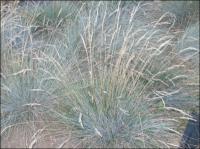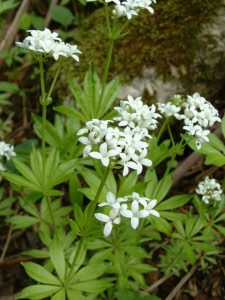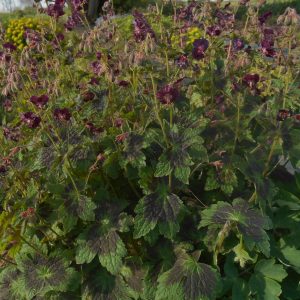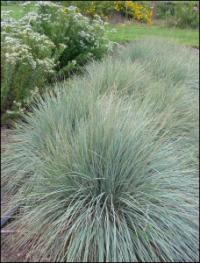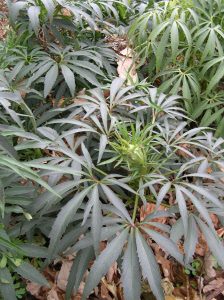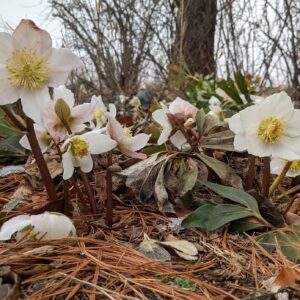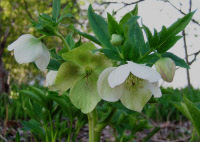Deer Resistant Plants
Showing 65–72 of 163 results
-
Festuca ovina var. glauca Blue fescue Z 4-10
Short mound of silvery blue spiky grass tufts. In summer short spikes of blue-green flowers.
Short mound of silvery blue spiky grass tufts. In summer short spikes of blue-green flowers.
Size: 12" x 10"
Care: full sun, well-drained soil
Native: temperate areas in Europe
Wildlife Value: host for larvae of a few butterfliesFestuca is Latin meaning “grass stalk..” This variety described and named in 1881
-
Galium odoratum Sweet woodruff, Bedstraw Z 4-8
Whorls of fine textured leaves, like spokes of a wheel, with white blooms in spring lighting up the shade
Whorls of fine textured leaves, like spokes of a wheel, with white blooms in spring lighting up the shade
Size: 6-12" x 18" spreading
Care: shade to part shade in moist to moist well-drained soil.
Native: Europe and Mediterranean areaCalled “Bedstraw” because, according to legend, Mary rested on hay of Bedstraw on Christmas. May wine made an ancient herbal remedy: handful of dried and crushed leaves plus fresh lemon juice steeped in wine for 3-4 hours “makes a man merry and (is) good for the heart and liver.” Garlands hanging in houses in summer “coole and make fresh the place, to the delight and comfort of such as are therein.” per English herbalist Gerard, 1633. Dried branches give a grassy vanilla fragrance, used in sachets and potpourris, as an insect repellant and to make grey-green dyes.
-
Geranium phaeum ‘Samobor’ Mourning widow Z 4-9
Very distinctive, variegated, chocolate-green chevron-marked leaves. Nodding, eggplant purple flowers in late spring-early summer.
Very distinctive, variegated, chocolate-green chevron-marked leaves. Nodding, eggplant purple flowers in late spring-early summer.
Size: 12-15” x 12"
Care: part sun to shade in moist well-drained soil
Native: Croatia
Wildlife Value: Deer & rabbit resistant. Attracts butterflies and other pollinatorsOK you caught me, it’s not heirloom – this had its 34th birthday in 2024. In three decades, it will be eligible for Social Security. It’s such a wonderful plant it’s Ok to make an occasional exception. It is a natural, genetic variant found growing in damp woods in Croatia. Named for the Croatian town of Samobor where the very first ‘Samobor’ still grows. Discovered in 1990 by Elizabeth Strangman of Washfield Nursery in Kent England.
-
Helictotrichon sempervirens Blue oat grass Z 4-9
June-October spikes rise above a rounded mound of thin, steel-blue, evergreen (sempervirens means always green) leaves – one of the best.
OUT OF STOCK
June-October spikes rise above a rounded mound of thin, steel-blue, evergreen (sempervirens means always green) leaves – one of the best.
Size: 4' x 2'
Care: full sun in moist well-drained to well-drained soil
Native: Europe
Awards: Elisabeth Carey Miller Botanical Garden Great Plant Pick, England’s Royal Botanical Society Award of Garden Merit.1st described in Prospectus de l’Histoire des Plantes de Dauphiné 17. 1779. Liberty Hyde Bailey said that Blue oat grass was “scarcely grown as ornamental subjects.”(1933)
-
Helleborus foetidus Bear’s foot Z 5-8 POISON
Nodding chartreuse cups with purple accents emerge in March-April from evergreen, palmate foliage. As much as a Robin - the 1st sign of spring.
Nodding chartreuse cups with purple accents emerge in March-April from evergreen, palmate foliage. As much as a Robin – the 1st sign of spring.
Size: 12-24" x 18-24"
Care: full to part shade in well-drained to moist well-drained soil.
Native: W. Europe
Awards: Great Plant Pick Award from Elisabeth Carey Miller Botanical Garden; England’s Royal Horticultural Society Award of Merit.
Size: Deer and rabbit resistantThe name Helleborus is Greek from hellein meaning “to kill” and bora meaning “food” referring to the plant’s poisonous qualities if eaten. Foetidus because crushed leaves are malodorous, but the flowers are sweetly fragrant. In gardens before 1753. In 1876 it was a “well known old-fashioned plant…” The Garden.
-
Helleborus niger Christmas rose, Black hellebore Z 5-8 POISON
Outfacing, white, waxy cup-shaped flowers resembling single roses in late winter, evergreen leaves.
OUT OF STOCK
Outfacing, white, waxy cup-shaped flowers resembling single roses in late winter, evergreen leaves.
Size: 12-20” x 12”
Care: part shade in moist well-drained soil
Native: rocky places in Europe
Awards: Received Royal Horticultural Society Award of Merit.The name Helleborus is Greek from hellein meaning “to kill” and bora meaning “food” referring to the plant’s poisonous qualities if placed in food. This species is ancient – known as long ago as 300 BC in Greece where it “purged and cured the mad or melancholicke daughters of Praetus with the roots thereof.” (Parkinson, 1629) Grown in the Eichstätt Garden, the garden of Johann Konrad von Gemmingen, prince bishop of Eichstätt in Bavaria, c. 1600. In Middle Ages petals thrown on floor to drive out evil and ward off power of witches. English herbalist John Gerard (1545-1612) strangely recommended it for curing poisoned animals. Sorcerers made themselves invisible by tossing the powdered plant in the air.
-
Helleborus orientalis Lenten rose Z 4-9 POISON
Creamy white to pink, waxy saucer-shaped flowers with glowing yellow stamens flowering in early spring with waxy, thick leaves.
Creamy white to pink, waxy saucer-shaped flowers with glowing yellow stamens flowering in early spring with waxy, thick leaves.
Size: 12” x 12”
Care: moist humusy soil in part shade.
Native: Asia Minor
Wildlife Value: its flowers produce large amounts of nectar and pollen feeding many bees, moths, butterflies, and some birds in early spring when few other plants in flower. Deer and rabbit resistant.
Awards: Missouri Botanic Garden Plant of Merit.The name Helleborus is Greek from hellein meaning “to kill” and bora meaning “food” referring to the plant’s poisonous qualities if placed in food. This was identified by Dioscordies in De Materica Medica for medicinal use around 70 A.D. This species found in India in 1839. Favorite plant of Gertrude Jekyll, mother of the mixed perennial border, (1848-1931) planted with Daphne shrubs and Dog tooth violet in her personal garden at Munstead Wood.
-
Hesperaloe parviflora Red Yucca Z 6-9
Cerise scarlet trumpets up and down the flower spike in summer
OUT OF STOCK
Cerise scarlet trumpets up and down the flower spike in summer
Size: 3’ x 5’
Care: sun moist well-drained to dry soil
Native: Europe, west & central Asia
Wildlife Value: Attracts butterflies & hummingbirds. Deer and rabbit tolerant,Named by Dr. George Engelmann, a German physician and plant fanatic who emigrated to America in the early 1800’s, settling in St. Louis.

